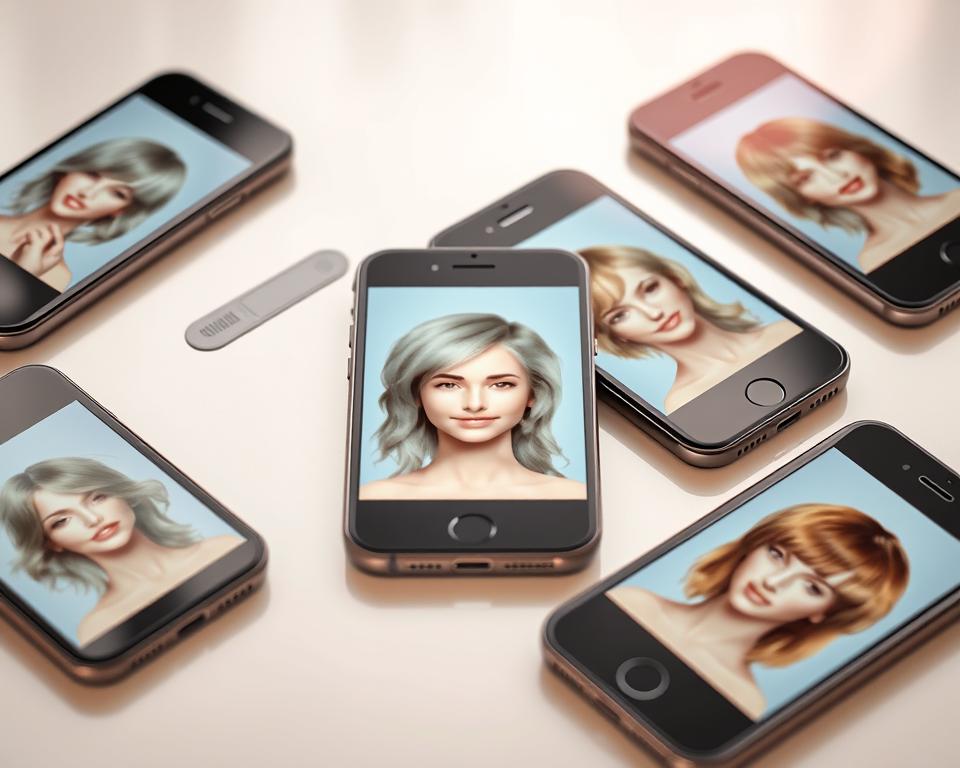App Simulates a new haircut
Advertisements
Imagine experiencing a completely different look without having to risk your locks. Thanks to artificial intelligence, this possibility is now a reality. Digital tools analyze facial features and hair textures to create accurate simulations, allowing you to visualize changes as if you were in a salon.
This technology eliminates the fear of choosing a cut that doesn't match with your face. Just upload a photo: advanced algorithms adjust hairstyles realistically, taking into account details such as volume and movement. You save time and money by avoiding unnecessary visits to professionals.
The benefits go beyond practicality. Many users report greater confidence when they try out bold styles virtually before making a decision. For hairdressers, these tools are allies when it comes to aligning expectations with clients.
Advertisements
Today, anyone can explore new looks in just a few clicks. The evolution of these systems has democratized access to hair experimentation, making transforming your look a safe and fun experience. How about finding out what you would look like with a modern gradient or a short fringe?
Introduction
How many times have you stopped yourself from innovating because you were afraid of an unwanted result? According to recent research, 7 out of 10 people are indecisive about changing their hair. Round faces, thin hair or even your daily care routine make choosing the right hairstyle a difficult task. ideal hairstyle a real puzzle.
Advertisements
Here comes the technology as an ally. Digital platforms analyze your unique characteristics to suggest compatible styles. You can try everything from super short cuts to vibrant colors – all without moving a single hair.
These tools solve two problems: they eliminate the risk of regret and save hours in the salon. Many users report that seeing the changes in advance reduces anxiety and increases satisfaction with the final result.
The best part? Virtual try-on has democratized access to personal transformation. Now, anyone can explore different looks for free, as many times as they want. It’s like having a personal style consultant, available 24 hours a day.
What is a haircut simulator?
Have you ever thought about testing hair transformations with scientific precision? These systems combine artificial intelligence and facial recognition to create hyper-realistic projections. They analyze more than 50 points of your face – such as shape, angles and proportions – to suggest styles that harmonize with your features.
The technology behind it works in three steps: first, algorithms map your facial structure through images sent. Then, by cross-referencing data on hair texture and density, they virtually adapt pre-registered cuts. Finally, they render the result, even considering how the light interacts with the new look.
Platforms range from application basic software for smartphones to professional software used in salons. The most advanced ones integrate augmented reality, allowing you to see different angles of the simulated hairstyle in real time. Some even predict how your hair will grow after the cut.
Despite the accuracy, there are limitations. Very light shades or extremely fine strands can challenge the algorithms. Developers are refining the systems to better understand natural hair movement and variations in shine. The evolution is constant – each update brings more convincing results.
Features of Haircut Simulator Apps
How about seeing what you would look like with a totally new look in three steps? These resources combine advanced technology and intuitive design to create personalized experiences. The magic begins with your self-portrait and evolves into projections that look like they came straight out of a premium salon.
Upload photos and select hairstyles
The first step is to send a photo clear with uniform lighting. Systems automatically analyze facial angle and hair texture. Avoid strong shadows or accessories that cover the forehead – details like these ensure accurate results.
In the library of hairstyles, you filter options by length, style, or trends. Some platforms suggest cuts based on your face shape. Zoom and rotate tools help you virtually adjust each strand.
Use of artificial intelligence in simulation
THE artificial intelligence cross-references data from 40 facial points with recognized beauty standards. Algorithms predict how each cut interacts with your natural expressions. Finger pinching movements allow you to adapt details such as volume or the nape of the neck.
Those resources learn from millions of previous simulations. Results improve with each update, even considering the natural curvature of the hair. interface simple hides complex calculations that replicate real physics of capillary movements.
App Simulates a New Haircut: Advantages and Challenges
Transforming your look has never been so safe and affordable. cutting simulators eliminate financial and physical risks: you can try out radical colors or asymmetrical cuts without compromising your hair. The practicality is unmatched – try out different looks on public transport or at home, as many times as you want.
In addition to convenience, these applications boost self-confidence. Many users report greater courage to make drastic changes after seeing previous results. Beauty professionals also benefit, using simulations to align expectations with clients during consultations.
However, there are challenges. Accuracy depends on the quality of the photos submitted – blurry images or images with uneven lighting result in less accurate projections. Complex hair textures, such as very tight curls, still challenge some algorithms.
Another critical point is the need for a stable connection. In areas with slow internet, loading results can frustrate the experience. Even with advances, cuts that require specialized manual techniques are still not perfectly replicated in virtual environments.
The constant evolution of these tools promises to overcome current limitations. In the meantime, they remain a smart option for those who want to renew their look safely and creatively.
Main differences between simulators available on the market
How to choose the right tool to transform your look? Platforms vary in resources, accuracy, and subscription models. While free options offer basic functionality, premium versions bring complete libraries and advanced tweaks.
Free vs Premium Features
Free versions allow you to test simple cuts and some colors, but with limitations. Hair Filter, for example, charges R$ 29.99 per year to unlock 3D textures. Hairstyle Try On, on the other hand, requires R$ 87.99 per month to access more than 600 styles – a value that can be worth it for professionals.
Some simulators use hybrid strategies. Facelab offers free virtual haircuts, but charges R$199.90/year for features like hair growth prediction. Hair Vision offers realistic tests for R$59.90/year – R$451.90 cheaper than the monthly fee.
Realistic interface, customization and results
THE interface Facetune’s intuitive (R$ 154.99/year) feature lets you adjust each strand with simple gestures. Premium systems use AI to replicate even light reflections on colored strands. While free versions show static cuts, subscriptions include animations that simulate natural movement.
When choosing, evaluate the resolution of the projections and options customization. Paid tools usually allow you to modify density, hair direction and even combine multiple styles. The investment is worth it for those looking for frequent experimentation or professional precision.
Top apps: discover the best haircut simulators
Discover the main applications that transform your self-image in seconds. Hair Filter (iOS) stands out for its cuts inspired by celebrities such as Angelina Jolie and Bradley Cooper. Hairstyle Try On (Android) impresses with more than 600 models and the option to virtually try on glasses.

For those looking for free, Facelab (Android/iOS) offers 100% of the basic tools at no cost. Facetune (both platforms) automates the entire process using advanced artificial intelligence. The variety is a trademark of YouCam Makeup, with over 40 makeup styles hairstyles different.
Unusual features to highlight: Fotor reveals what you would look like bald, while MyEdit works entirely online. Change Hairstyle AI makes it easy to share results on Twitter in two clicks. Platforms like Hair Vision (iOS) have limited free versions but offer ultra-realistic simulations on paid plans.
When choosing, evaluate the variety of cropping and extra features. Professionals may prefer premium options like PhotoDirector, which uses 3D avatars. For casual experimentation, applications Free ones like MyEdit work well. Each platform has its strengths – try several to find your perfect match!
Comparison between Android and iOS apps
Choosing between Android and iOS makes a difference in the hair simulation experience. application Hair Filter only works on iPhones, offering celebrity cuts with high precision. Hairstyle Try On dominates on Android, offering over 600 types of hairstyles to try.
Platforms like Facelab work on both systems, ideal for those who switch devices. Facetune surprises with millimeter adjustments in photos, using AI to adapt cuts to form of your face. Paid versions include 3D filters that even replicate the texture of your hair.
When testing courteous, Android offers more free variety. iOS shines in realistic renderings, especially in models with movement. Both require photos sharp for accurate results – uneven lighting distorts projections.
Prefer flexibility? Cross-platform apps allow you to continue projects on any device. Analyze types of available styles and unique features before you choose. This way, you can find the court perfect for your look, regardless of operating system.

Calvin Bassey is a dedicated writer and parenting enthusiast passionate about guiding expectant parents through the journey of pregnancy. With a deep understanding of maternal health and baby care, he provides practical and insightful advice to help families prepare for childbirth and early parenthood. His work at Brimvue focuses on empowering parents with knowledge, ensuring they navigate this transformative experience with confidence and ease.

